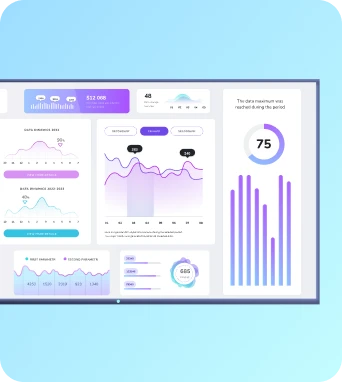Android digital signage player
An Android digital signage player is an Android device or dedicated application that delivers scheduled multimedia playlists, HTML5 dashboards and data-driven layouts to TV and workplace displays. It connects to cloud platforms such as Fugo.ai for remote provisioning, content updates, reporting and integration with calendars, APIs and business intelligence feeds to automate screen content.
What is Android digital signage player?
Playback architecture, rendering stacks and media handling on Android players
Android players rely on a layered playback architecture that combines platform media frameworks, a rendering engine and the player application that orchestrates playlists and schedules. At the platform level ExoPlayer or the native MediaPlayer will handle decoding; ExoPlayer is commonly used for signage because it supports adaptive streaming, custom buffering and smooth seeking for long-form video and HLS/DASH streams. Hardware acceleration via device codecs is essential for consistent performance: a capable player will use the platform’s hardware decoders for H.264 and H.265 rather than software fallbacks to avoid CPU saturation. In a real-world example, a 4K promotional loop encoded with HEVC should be tested to confirm the device uses the hardware decoder; if the device software falls back to software decoding, frame drops and overheating can occur during extended playback. The rendering stack then composes decoded frames with overlays such as timestamps, RSS feeds or live dashboards implemented via lightweight WebView instances or dedicated HTML5 engines. Web-based dashboards should be profiled for GPU-accelerated CSS transforms and reduced main-thread work, because excessive JavaScript can cause jank and interfere with scheduled transitions. Content handling also requires robust caching and offline behaviour. A proper signage player will prefetch assets according to schedule windows, maintain a persistent cache and validate checksums to avoid corrupted playlists. For example, when pushing a multi-zone layout via a management platform, assets for each zone should be downloaded and verified ahead of play time; the player can then switch instantly between playlists without network latency. Edge cases like intermittent connectivity demand fallback rules: local playlists, low-resolution substitutes or looping cached content until connectivity is restored. From an integration standpoint, the player must expose APIs or telemetry endpoints so platforms such as Fugo.ai can collect playback state, health metrics and snapshot images. Inline examples include an HTTP endpoint the player exposes for status, or a webhook the player calls on critical events; these allow central systems to trigger remediation, report failures or adjust content dynamically based on device-level metrics without manual intervention.
Deploying and managing Android signage players at scale
Deploying Android signage players across dozens or thousands of locations requires a device provisioning strategy, consistent OS baselines and a plan for remote updates and monitoring. Begin by selecting hardware with a known Android version and vendor support, and validate the device against your content profile: test video codecs, HTML5 performance and uptime under continuous playback. For enterprise rollouts enable kiosk mode or lock the player app to single-app operation to prevent accidental navigation away from content. Many organisations use Android zero-touch enrolment or an MDM solution to pre-install and automatically enroll the Fugo player app with a signed token, which removes manual set-up on site. In practical terms, an IT team might ship devices with a provisioning file or QR code so installers can unpack, power on and have the unit enrol and download its assigned playlist and device policy without additional steps. Common pitfalls include mismatched Android API levels, aggressive power-saving settings and unmanaged WebView updates that change behaviour after an OTA. Avoid these by locking down system updates where possible, disabling deep sleep for active signage zones and configuring the player to keep the display awake for scheduled hours. Monitoring and optimisation are ongoing tasks: implement remote logging, periodic screenshots and health checks so the management platform can detect frozen playback, network dropouts or high CPU usage. For example, schedule a rolling audit where devices send a heartbeat every five minutes and upload a thumbnail on failed heartbeats; the platform can then restart the player or escalate to IT. Optimisation techniques include reducing rendering complexity in HTML dashboards, serving appropriately encoded media for the device’s resolution to avoid unnecessary GPU work, and tuning buffer sizes for live feeds to balance latency and smoothness. Fugo.ai and similar platforms provide automation hooks to push updates, change playlists by tag, and collect playback diagnostics so ops teams can diagnose issues without physical access. By combining disciplined provisioning, continuous monitoring and media-aware optimisation, large signage estates can maintain high availability and predictable performance.
Final Thoughts on Android digital signage player
Keep the learning going...
Ambilight effects
Ambilight effects are dynamic ambient lighting techniques that extend on-screen visuals into the surrounding environment by sampling or analysing content and driving LED or display lighting. In digital signage they boost perceived contrast and brand presence, reduce eye strain, and create immersive dashboards and workplace displays that react to scheduled or live content.
Animated widgets
Animated widgets are dynamic, self-contained content modules for digital signage that use vector animation, sprite sequences or timed transitions to convey information. They combine data bindings, animation timelines and lightweight assets to deliver attention-grabbing, loopable content on TV dashboards, workplace displays and networked signage players.
Anti-glare coatings
Anti-glare coatings are thin surface treatments applied to display glass or acrylic that diffuse specular reflections and reduce visible glare. In digital signage they improve legibility, contrast and colour fidelity in bright or mixed lighting, helping TV dashboards and workplace displays remain readable from multiple viewing angles and under ambient light.



